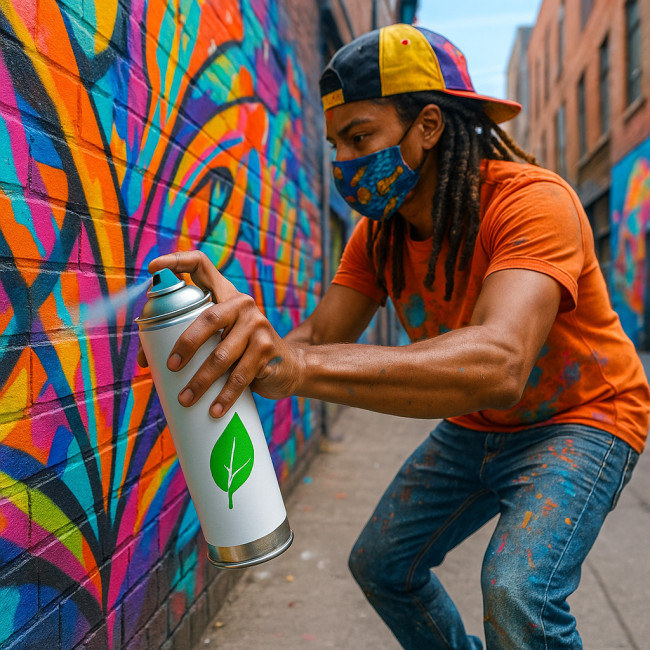Sustainable spray paint options: eco choices that keep street colors vibrant
Switching to sustainable spray paint no longer means sacrificing opacity, drying time or a punchy palette. This guide walks you through the newest eco-friendly aerosol formulas, how they stack up on performance, and smart habits that keep your next mural vivid and planet-positive.
Why eco-friendly spray paint matters in 2024

A single conventional aerosol can release up to 420 g of volatile organic compounds (VOCs). Multiply that by an average 40-can wall and you equal the yearly emissions of a small car. Beyond air quality, traditional paints rely on virgin metals for cans and fossil-fuel propellants. Adopting greener paints helps you meet local clean-air bylaws, reassure eco-minded clients and attract brand activations that prioritise sustainability—similar to the way eco-certified material choices boost trust in other creative sectors.
Criteria to evaluate sustainable spray paint
1. Low-VOC or zero-VOC binders
Look for labels below 100 g/L VOCs. Water-based acrylic resins usually sit under 50 g/L, while new bio-solvent blends stay under 80 g/L without compromising flow.
2. Climate-friendly propellants
Many brands have swapped hydrofluorocarbons for dimethyl ether or compressed air. The change cuts greenhouse potential by up to 90 %. Check Safety Data Sheets (SDS) for GWP values <10.
3. Recycled and recyclable packaging
Cans with ≥25 % post-consumer steel reduce mining demand. Make sure the nozzle, gasket and cap are PET or HDPE for easy curbside recycling.
4. Responsible pigment sourcing
Ask brands about heavy-metal-free colourants and transparent supply chains—an approach echoed in sustainable material sourcing plans across design fields.
Top eco spray paint brands compared
| Brand | Base | VOC (g/L) | Opacity (1-coat) | Dry-to-touch | Recycled Metal % |
|---|---|---|---|---|---|
| EcoMist H2O | Water acrylic | 30 | High | 10 min | 40 % |
| GreenFlow Bio-Solv | Bio-solvent | 50 | Very high | 8 min | 35 % |
| Re-Can Loop | Hybrid acrylic | 70 | High | 7 min | 60 % |
| AeroAir Neo | Compressed-air | 80 | Medium | 12 min | 25 % |
| Chromatic Zero | Zero-solvent | <10 | Medium-high | 15 min | 45 % |
Cost versus emissions: visual snapshot
Source : Green Coatings Annual Report 2024
The graphic highlights how water-based cans can cost a euro more than solvent types yet slash VOCs by over 80 %. When pitching large-scale projects, add these numbers to your proposal pack—mirroring the data-led approach outlined in eco-smart material roadmaps.
Techniques to lower your mural's footprint
- Batch colours: Finish all areas of one hue in a single session to avoid extra purge sprays.
- Nozzle care: Soak caps in biodegradable citrus cleaner; reuse up to five cycles.
- Trigger extenders: Fit reusable grip handles to improve accuracy and cut overspray by 15 %.
- End-can recycling: Depressurise empties with a certified puncture tool and drop them at local steel recovery points.
- Low-pressure modes: Choose caps rated under 1.5 bar for details; they emit 20 % less propellant.
Working with clients who demand proof

Cities like Los Angeles and Paris now include VOC caps in public-art permits. Keep SDS sheets and third-party eco labels on file, and embed them in cloud folders you share with commissioners. That diligence mirrors the transparent communication styles discussed in clear mural commission briefs. When showcasing past projects on visual platforms, link to a profile such as the Image Designers mural portfolio to underline professional standards.
Maintenance tips that extend colour life
- Apply UV-resistant clear coats with ≤50 g/L VOCs two hours after the final layer.
- Choose south-facing walls with minimal standing water exposure.
- Schedule annual gentle washdowns using pH-neutral soap to remove soot.
- Document the process through time-lapse—doubling as marketing collateral to attract sustainable-minded brands, akin to tactics in eco-friendly film production.
Green graffiti IQ quiz
FAQ
- Do eco spray paints work on concrete as well as traditional cans?
- Yes. Modern water-based formulas offer comparable adhesion and often include nano-resins that bond strongly to porous surfaces.
- Will switching to low-VOC paints change my colour palette?
- Not anymore. Most sustainable ranges now exceed 180 hues, including fluorescents and metallics.
- How should I dispose of half-full cans?
- Contact a local hazardous-waste facility. Never perforate or incinerate partially full aerosols.
- Are eco propellants safe to inhale?
- While they reduce environmental damage, respiratory protection is still required. Use a P100 mask during spraying.
Ready to paint responsibly?
By choosing low-VOC cans, recycled steel packaging and mindful techniques, you cut emissions, win eco-focused commissions and future-proof your art practice. Bookmark this guide, share it with your crew and start your next wall with a greener grip.
Action step: Create a mini audit of your current paint stock tonight—note VOC levels, propellants and recycling plans, then swap any outliers on your next supply run.











